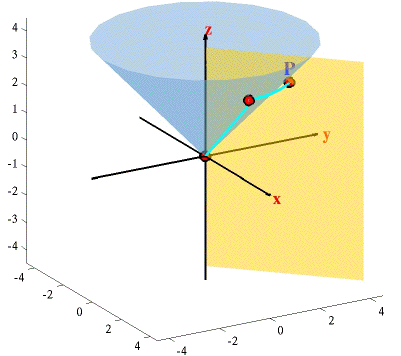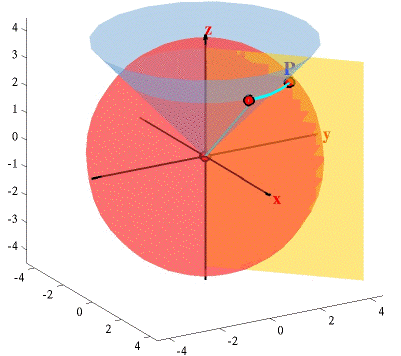Spherical Coordinates in Three Dimensions
A point in three dimensional space is designated by spherical coordinates in the following way:
| r: |
|
the distance from the origin |
| q: |
|
the angle rotated from the positive x–axis (azimuth) |
| f: |
|
the angle rotated from the positive z–axis (declination) |
The point P in the figures below is the point designated by r =  ,
,
 , and
, and
 (the cartesian coordinate (2, 2, 3)). The coordinate transformations are the following:
(the cartesian coordinate (2, 2, 3)). The coordinate transformations are the following:
Cone  and plane
and plane 

Cone  , plane
, plane  , and sphere r =
, and sphere r = 
 The figures above depict the level surfaces for spherical coordinates. The surface r = c, (c > 0) is a sphere of radius c since r is the distance a point is from the origin. So we are looking at all the points that are the same distance from the origin. The surface
The figures above depict the level surfaces for spherical coordinates. The surface r = c, (c > 0) is a sphere of radius c since r is the distance a point is from the origin. So we are looking at all the points that are the same distance from the origin. The surface  = c is a plane containing the z–axis similar to cylindrical coordinates. The surface f = c defines all the points that lie on a line rotated an angle of c radians from the positive z–axis. If we allow r and q to take on any values the surface generated is a cone. The figures above also indicate how a point is located using spherical coordinates. Move from the origin on the cone given by f until a distance r from the origin, all of this is done directly above the x–axis.
= c is a plane containing the z–axis similar to cylindrical coordinates. The surface f = c defines all the points that lie on a line rotated an angle of c radians from the positive z–axis. If we allow r and q to take on any values the surface generated is a cone. The figures above also indicate how a point is located using spherical coordinates. Move from the origin on the cone given by f until a distance r from the origin, all of this is done directly above the x–axis.
 Back
Back
![]() ,
,
![]() , and
, and
![]() (the cartesian coordinate (2, 2, 3)). The coordinate transformations are the following:
(the cartesian coordinate (2, 2, 3)). The coordinate transformations are the following:

